European Cherry Fruit Fly (Rhagoletis cerasi)
French common name: la mouche européenne des cerises
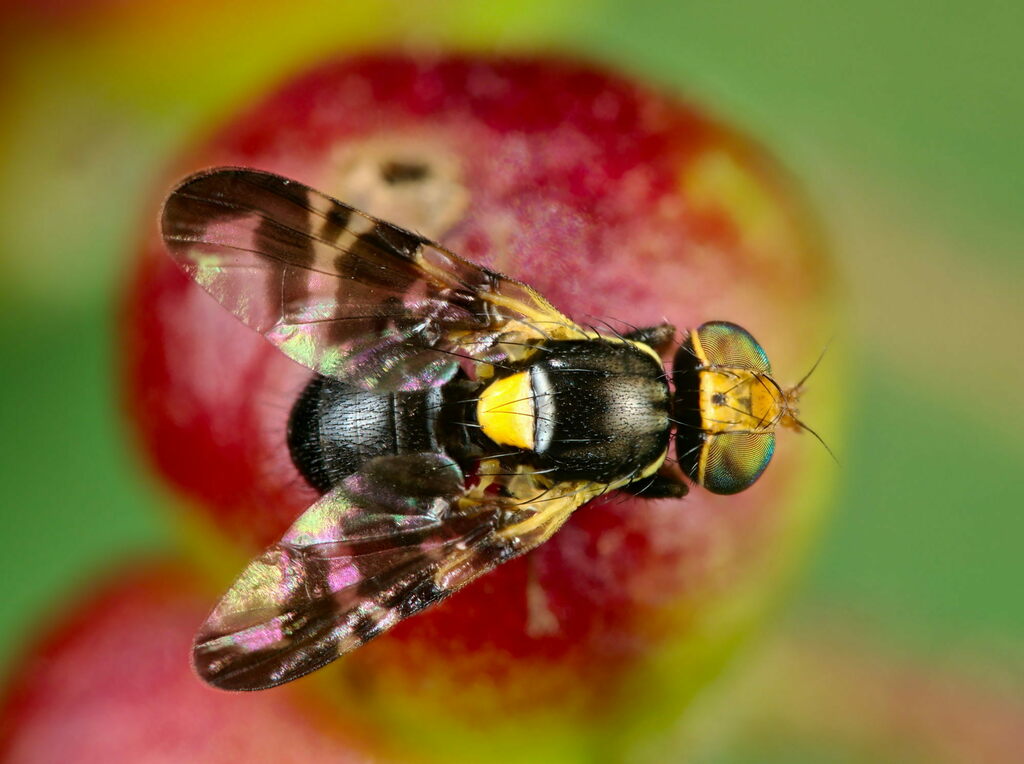
Adult European cherry fruit fly
Observation by Gilles San Martin, iNaturalist.org
Order: Diptera
Family: Tephritidae
Did you know? During their pupal stage, the European cherry fruit fly can remain dormant in the soil for up to three years.
Introduction
The European cherry fruit fly is a serious agricultural pest of cherries native to Europe. When uncontrolled, damage to cherry fruit by fly larvae can result in produce losses of up to 100% and cause significant economic losses. The damage begins when an adult fly lays an egg in the unripe fruit of its host plant. As the fly larva develops, it tunnels through the ripening fruit feeding and defecating. This renders infested fruit inedible and unsellable. There are several species of cherry and honeysuckle plants that can host the European cherry fruit fly. In Canada, the European cherry fruit fly has been detected in association with invasive honeysuckle found in urban parks in Southern Ontario. Further spread of this pest poses a severe threat to Canada’s cherry industry. To prevent the spread, the European cherry fruit fly is regulated as a quarantine pest in Canada under the plant protection directive.
General Information
Adult fruit flies range from 3.5 to 5.0 mm long and are mainly dark brown to black in colour with a tan to orange coloured head. Their scutellum, a shield shaped part located at the base of their thorax, is a distinct bright yellow colour. The lower portions of their legs are similarly yellow. The European cherry fruit fly can be distinguished from other fly species in the Rhagoletis genus by the characteristic dark blue-black crossbands on its transparent wings.

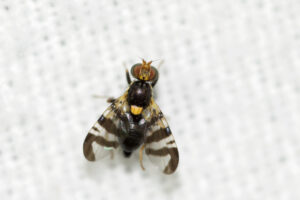
There are several Rhagoletis fly species found throughout North America that may be confused for the European cherry fruit fly. Similar looking pest species include the apple Maggot (Rhagoletis pomonella), blueberry maggot (Rhagoletis mendax), eastern cherry fruit fly (Rhagoletis cingulata), western cherry fruit fly (Rhagoletis indifferens), walnut husk fly (Rhagoletis completa), and black cherry fruit fly (Rhagoletis fausta). Examination of differing wing banding patterns can be used to distinguish between species.
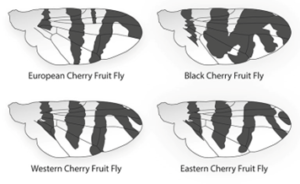


The European cherry fruit fly is known to be active earlier than other native fruit fly species and will attack fruits which are still unripe (Daniel and Grunder, 2012). The European cherry fruit fly has only one generation per year. Adult flies emerge in the spring, during the months of May to July and live for an average of two to four weeks. During this time adult female flies will deposit one egg under the skin of a fruit via its ovipositor. Female flies have been observed to prefer fruit that are located in full sun and may lay 30 to 200 eggs during their lifespan. Once the egg has been deposited the fly will mark the fruit with a pheromone that deters other females from selecting that fruit (Daniel and Grunder, 2012). This ensures maximum resource availability for a single larva. Larvae hatch after one to two weeks and develop while feeding within the fruit.
The larval life cycle of the European cherry fruit fly is divided into three instars, or growth stages. During the third instar, larvae are 5-6 mm long, 1.2-1.5 mm wide, and white or yellowish in colour. Hardened, protruding mouth-hooks are present on the head, while rows of small spines line the larvae’s bodies. After six weeks the mature larvae exit the fruit and fall to the ground. Once there, they burrow approximately 1-13 cm into the soil at the base of the host plant and pupate. The pupae remain dormant in the soil for a winter diapause that typically lasts 180 days. However, some pupae will remain dormant for up to three years. Pupae require temperatures of 7°C or lower for successful development. Overwintering pupae are 3-4 mm long and are often pale yellow-brown in colour.

Several species of cherry in the genus Prunus, including sweet cherry (P. avium), sour cherry (P. cerasus), black cherry (P. serotina) and mahaleb cherry (P. mahaleb) are considered at risk of attack from this fly. Certain species of honeysuckle (Lonicera spp.), many of which are invasive to North America, can also host the European cherry fruit fly. In Canada, the European cherry fruit fly has been found on the invasive honeysuckles L. xbella, L. morrowii, and L. tartarica. In Europe, host honeysuckle species include L. xylosteum, L. tartarica, and L. alpigena.
The main harm to the cherry fruit occurs when the fly is in its larval stage. A female fruit fly will lay an egg under the skin of the fruit, often resulting in discoloured and softened tissue surrounding the puncture mark. Initially, fruit containing fly larvae may not show significant signs of infestation. However, fruit may develop rotten spots, soften prematurely, shrivel, or fall from the tree as the larvae feed and develop (Spears and Alston, 2023). Exit holes will also be visible on the fruit once the larvae have emerged.
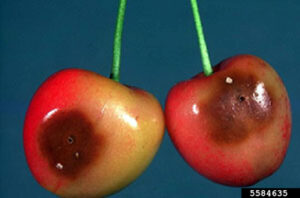
The European cherry fruit fly is native to most of Europe, excluding the United Kingdom, and is also present in some temperate regions of Asia.
The first detection of the European cherry fruit fly in North America was confirmed in June 2016 in Mississauga, Ontario. In early February 2016 a photograph of the fly was taken in the Riverwood Conservancy and submitted to the Canadian Food Inspection Agency (CFIA). The CFIA performed a trapping survey in May of 2016 and the presence of the European cherry fruit fly in association with invasive honeysuckle (Lonicera spp.) was confirmed in June 2016 (Barringer, 2018). It has since been detected in relation with invasive honeysuckles in two urban parks in Montreal, Quebec in 2022. Fortunately, this pest has not yet been reported in association with commercial cherry production.
In 2017, the first detection of the European Cherry Fruit fly in the United States occurred in Niagara County, New York State near wild cherry and honeysuckle populations. Official control measures in areas where the fly has been detected have been implemented by the United States Department of Agriculture – Animal and Plant Health Inspection Service (USDA-APHIS).
It is possible that the European cherry fruit fly was introduced to North America via the importation of infested fresh cherry fruit or soil containing pupae brought in with host plant species (Barringer, 2018).

Ecological Impacts
This pest is considered unlikely to cause significant ecological impacts. It only attacks the fruit of its host plant species and does no other damage to infested plants. Seeds from infested fruit are also unaffected by the larva and remain viable (Landry and Mordecai, 2016). Additionally, infested fruit can still be consumed by animals.
That said, control measures, such as chemical sprays, used to manage infestations of this pest, may potentially impact the environment (Landry and Mordecai, 2016).
Economic & Social Impacts
The establishment of the European cherry fruit fly in North America poses a significant threat to Canada’s cherry production. For example, sweet and sour cherries are an important tender fruit crop in Ontario, particularly in the Niagara region and Carolinian zones. Produce losses of up to 100% are possible if infestations of this pest are left uncontrolled. Fruit that has been infested by fruit fly larvae is inedible and thereby unmarketable due to damage resulting from larval feeding and contamination by larvae feces. Serious infestations of the European cherry fruit fly in orchards would result in large economic losses for cherry growers.
In Europe, higher infestation levels have been observed in sweet cherry orchards (Prunus avium) (Daniel and Grunder, 2012). In Canada, sweet cherry trees can only be grown in a few temperate regions due to frost sensitivity. More than 90% of Canada’s sweet cherry orchards are located in the southern-interior of British Columbia while the remaining are located in southern Ontario, in the Greenbelt. In 2023, sweet cherries accounted for 6.3% of Canada’s fruit export value, making them the country’s third most exported fruit after blueberries and cranberries. Sweet cherries also accounted for $98 million of Canada’s farm-gate value. Infestation of Canada’s sweet cherry orchards would have a drastic impact on Canada’s fresh cherry production.
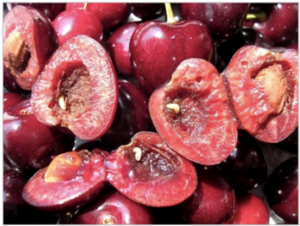
This agricultural pest can be introduced to new areas through the movement of fresh fruit or soil containing pupated larvae from areas where host plants are grown.
The CFIA plant protection directive D-17-03, which came into effect on June 1, 2017, outlines import and domestic phytosanitary requirements intended to prevent further spread of this pest within Canada. Regulated areas include the provinces of Ontario and Quebec in Canada and the State of New York in the United States. Fresh cherry fruit regulated under this directive include sweet cherries, sour cherries, mahaleb cherries, and black cherries. Processed fruit, such as frozen, canned or dried cherries, pose no risk of spreading this pest, and are therefore exempt from the directive.
Phytosanitary import requirements prohibit the importation of regulated cherry fruit to Canada from regulated areas in the United States. Domestic requirements prohibit the movement of regulated fruit to British Columbia. Regulated fruit may be moved to provinces other than British Columbia once it has been inspected, found to be free of pests, and the CFIA has issued a Movement Certificate. A Movement Certificate verifies that appropriate control measures for fruit flies were in place at the orchards of origin.
Control techniques currently used in many commercial European cherry orchards include chemical control through the repeated application of insecticide and biological control by the introduction of the entomopathogenic fungi, Beauveria bassiana (Daniel and Grunder, 2012). Other management measures include netting placed on the trees and soil, mass trapping of adult flies with baited yellow sticky traps, pruning of trees to improve chemical spray application, and allowing the grass under trees to grow as it delays adult fly emergence (Landry and Mordecai, 2016).

Resources
Further Reading
Barringer, L. (2018). First record of the European cherry fruit fly, Rhagoletis cerasi (Linnaeus) (Diptera: Tephritidae), in North America. Insecta Mundi, 0622, 1-4. https://digitalcommons.unl.edu/cgi/viewcontent.cgi?article=2132 context=insectamundi
Būda, V., Radžiutė, S., Apšegaitė, V., Blažytė-Čereškienė, L., Čepulytė, R., Bumbulytė, G., & Mozūraitis, R. (2022). Electroantennographic and behavioural responses of European cherry fruit fly, Rhagoletis cerasi, to the volatile organic compounds from sour cherry, prunus cerasus, fruit. Insects, 13(2), 114. https://doi.org/10.3390/insects13020114
Daniel, C., & Wyss, E. (2009). Susceptibility of different life stages of the European cherry fruit fly, Rhagoletis cerasi, to entomopathogenic fungi. Journal of Applied Entomology, 133(6), 473-483. https://onlinelibrary.wiley.com/doi/abs/10.1111/j.1439-0418.2009.01410.x
Daniel, C., and Grunder, J. (2012). Integrated Management of European Cherry Fruit Fly Rhagoletis cerasi (L.): Situation in Switzerland and Europe. Insects, 3(4), 956–988. https://doi.org/10.3390/insects3040956
Herz, A., Köppler, K., Vogt, H., Elias, E., Katz, P., & Peters, A. (2005). Biological control of the cherry fruit fly, Rhagoletis cerasi L. (Diptera, Tephritidae) by use of entomopathogenic nematodes: first experiences towards practical implementation. Organic Eprints. https://orgprints.org/id/eprint/8819/1/ecofruit_12th_12.pdf
KEPENEKCİ, İ., HAZIR, S., & ÖZDEM, A. (2015). Evaluation of native entomopathogenic nematodes for the control of the European cherry fruit fly Rhagoletis cerasi L. (Diptera: Tephritidae) larvae in soil. Turkish Journal of Agriculture and Forestry, 39(1), 74-79. https://journals.tubitak.gov.tr/agriculture/vol39/iss1/9/
References
Barringer, L. (2018). First record of the European cherry fruit fly, Rhagoletis cerasi (Linnaeus) (Diptera: Tephritidae), in North America. Insecta Mundi, 0622, 1-4. https://digitalcommons.unl.edu/cgi/viewcontent.cgi?article=2132 context=insectamundi
Carroll, J., & Herrmann, T. (2020). European Cherry Fruit Fly (Rhagoletis cerasi). New York State Integrated Pest Management Program — Invasive Species and Exotic Pests. https://ecommons.cornell.edu/server/api/core/bitstreams/0817e948-8c4f-407f-9841-52e0c468878e/content
Daniel, C., and Grunder, J. (2012). Integrated Management of European Cherry Fruit Fly Rhagoletis cerasi (L.): Situation in Switzerland and Europe. Insects, 3(4), 956–988. https://doi.org/10.3390/insects3040956
European cherry fruit fly (Rhagoletis cerasi). EDDMapS.org. https://www.eddmaps.org/species/subject.cfm?sub=12166
Government of Canada. (2024). D-17-03: Phytosanitary requirements to prevent the introduction and spread of Rhagoletis cerasi (European cherry fruit fly). Canadian Food Inspection Agency. https://www.inspection.gc.ca/en/plant-health/invasive-species/directives/date/17-03
Landry, C., and Mordecai, K. (2016, April 15). Rhagoletis cerasi (Linnaeus) European cherry fruit fly. United States Department of Agriculture – Animal and Plant Health Inspection Service. https://www.aphis.usda.gov/sites/default/files/rhagoletis-cerasi-report.pdf
Ministry of Agriculture, Food and Agribusiness and Ministry of Rural Affairs. (2022, June 29). Detecting European cherry fruit fly. Ontario.ca. https://www.ontario.ca/page/detecting-european-cherry-fruit-fly
Movement requirements for Ontario cherries. (2017, May 23). Canadian Food Inspection Agency. https://www.inspection.gc.ca/en/plant-health/invasive-species/insects/european-cherry-fruit-fly/ontario-cherries-faq
Rhagoletis cerasi (European cherry fruit fly) – Fact sheet. (2023, June 1). Canadian Food Inspection Agency. https://inspection.canada.ca/en/plant-health/invasive-species/insects/european-cherry-fruit-fly/fact-sheet
Spears, L., and Alston, D. (2023, December 29). European cherry fruit fly. North Central Integrated Pest Management Center. https://www.ncipmc.org/communications/pest-alerts/european-cherry-fruit-fly/
Statistical overview of the Canadian fruit industry, 2023. (2024). Government of Canada — Agriculture and Agri-Food Canada. https://agriculture.canada.ca/en/sector/horticulture/reports/statistical-overview-canadian-fruit-industry-2023
Yee, W. L., Hernández-Ortiz, V., Rull, J., & Sinclair, B. J. (2013, October). ST 04: Status of Rhagoletis (Diptera: Tephritidae) Pests in the NAPPO Countries. North American Plant Protection Organization (NAPPO). https://www.nappo.org/application/files/5815/8323/0052/Status_of_Rhagoletis_Pests_ST_04__18-03-2014_final-e.pdf#:~:text=In%20the%20North%20American%20Plant,(Loew)%2C%20western%20cherry%20fruit
This profile was created with support from the Greenbelt Foundation, which is a charitable organization solely dedicated to ensuring the Greenbelt remains permanent, protected, and prosperous.


